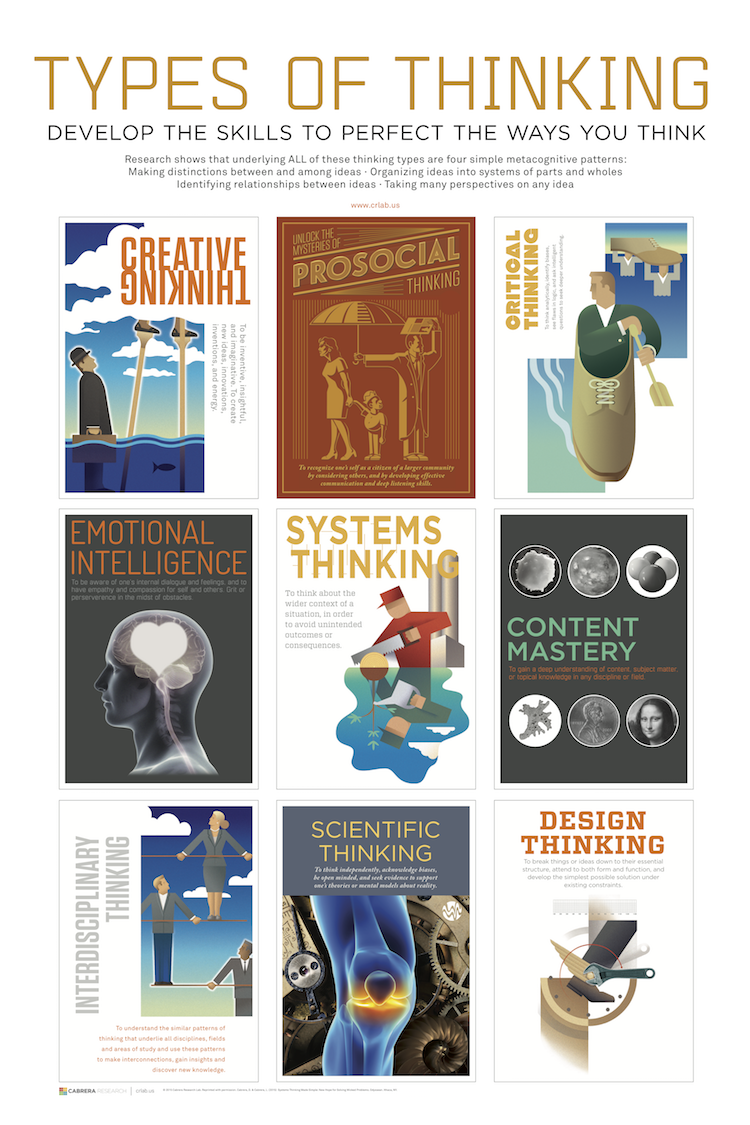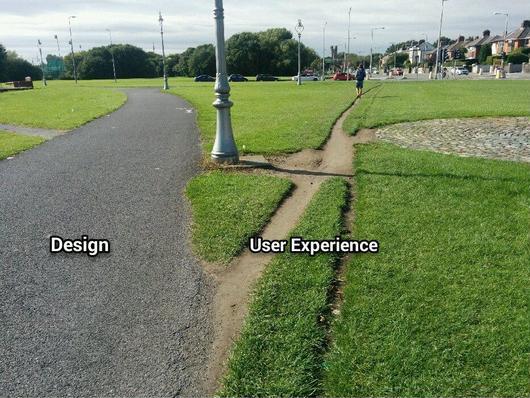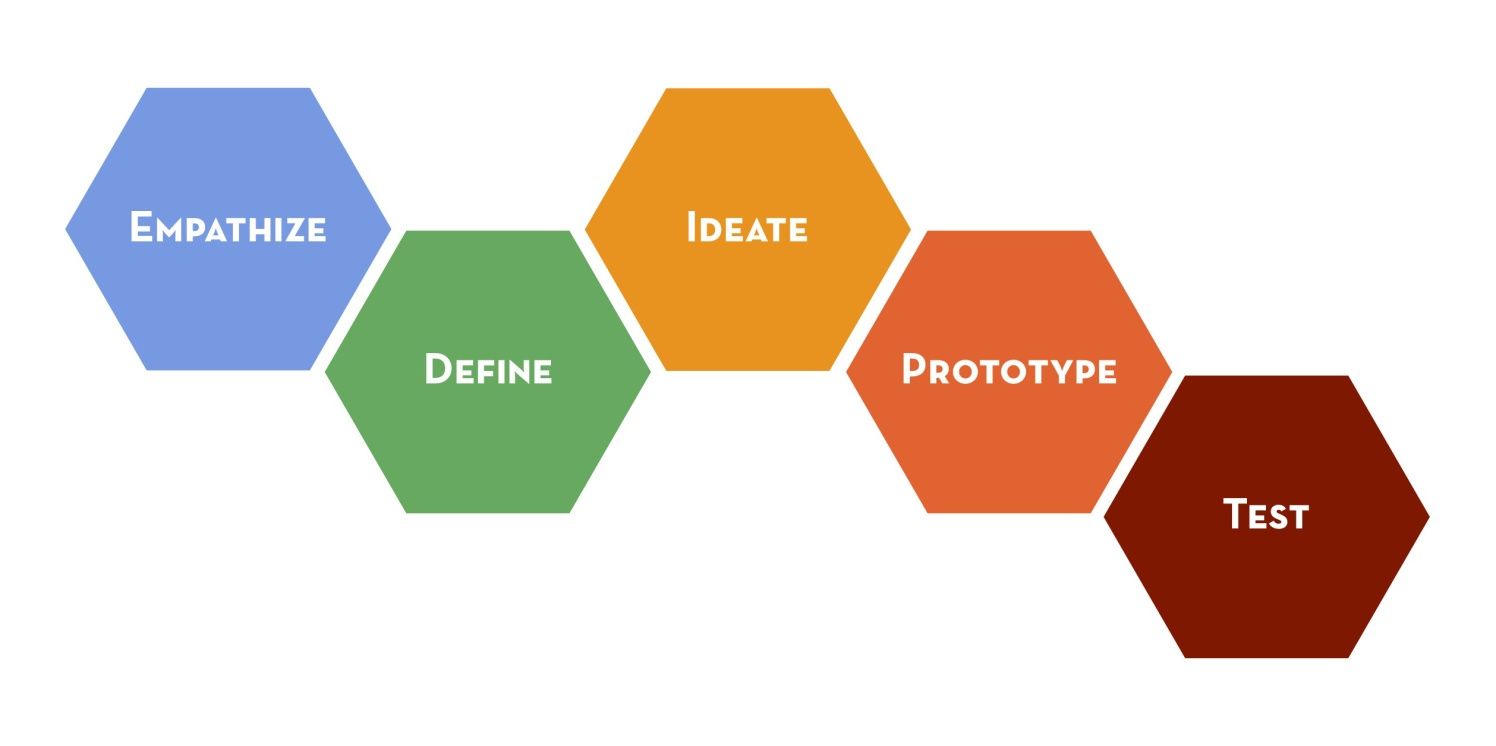Dealing with the Devil in Design Thinking
Design Thinking is the latest exotic heuristic to show up in fishmongers' stalls. The old saying, "give a man a fish and he eats for a day, teach a man to fish and he eats for a lifetime" comes to mind. On one hand, Design Thinking is something you could use off the shelf (buy some fish). Alternatively, by adding the foundational rules (DSRP) of Systems Thinking (ST), Design Thinking (DT) can be something you catch yourself, adapt on the fly, and make to order.

A heuristic is any approach to problem solving, learning, or discovery that employs a practical method not guaranteed to be optimal or perfect, but sufficient for the immediate goals[^n]
In fact, there are many types of thinking heuristics. Research shows that underlying ALL of these thinking types are four simple metacognitive patterns (DSRP):
- Making Distinctions between and among ideas.
- Organizing ideas into Systems of parts and wholes.
- Identifying Relationships between ideas.
- Taking many Perspectives on any idea.
Below is a poster with 9 important types of thinking (click here to download a free hi-res version). In this blog we will be delving deeper into Design Thinking (lower right).

First, What is Design Thinking?
Design Thinking originated at the Stanford University Design School. Their short description:[^n]
"The Design Thinking process first defines the problem and then implements the solutions, always with the needs of the user demographic at the core of concept development. This process focuses on need-finding, understanding, creating, thinking, and doing. At the core of this process is a bias towards action and creation: by creating and testing something, you can continue to learn and improve upon your initial ideas. The design thinking process consists of these 5 steps:

EMPATHIZE: Work to fully understand the experience of the user for whom you are designing. Do this through observation, interaction, and immersing yourself in their experiences.
DEFINE: Process and synthesize the findings from your empathy work in order to form a user point of view that you will address with your design.
IDEATE: Explore a wide variety of possible solutions through generating a large quantity of diverse possible solutions, allowing you to step beyond the obvious and explore a range of ideas.
PROTOTYPE: Transform your ideas into a physical form so that you can experience and interact with them and, in the process, learn and develop more empathy.
TEST: Try out high-resolution products and use observations and feedback to refine prototypes, learn more about the user, and refine your original point of view."
What does Design Thinking Do?
Design Thinking isn't just for products (like a iPhone). One can apply Design Thinking to designing political movements, designing a better social policy, a more sustainable product or service, creative endeavors, accessibility-increasing software, and life saving products, not just stereotypical consumer products. Design Thinking is about creating products (and programs and services) that better serve humans, thus the first step is based upon an empathic disposition. Design Thinking is less about creating a new whizbang product that no one needs and more about designing things that work for people. It is about making "user experience" central to "design".

The Upside and Downside of Design Thinking
The upside is that Design Thinking gives us 5 straightforward steps to design success. The downside is that the devil is in the details. While the 5 Steps of Design Thinking are clear, the sophisticated cognitive skills one needs to perform these steps successfully are opaque. DSRP, the cognitive code that underlies many thinking heuristics including Design Thinking, can help sort out the details and rid one of the devil. DSRP is an acronym that stands for: making Distinctions, organizing Systems, drawing Relationships, and taking Perspectives. We won't go into DSRP in depth here. There are numerous other places[^n] where it has been given a more extensive treatment. We will show you how together, Design Thinking + DSRP, leads to a powerful process.

Let me restate the five principles here, to provide a somewhat more critical summary of them:
| Design Thinking Steps | Intentionally Critical Rephrasing |
| Empathize | Figure out the customer's perspective at a really deep level |
| Define | State it clearly and synthetically |
| Ideate | Have brilliant ideas based on the perspective taking and synthetic thinking you did in Steps 1 & 2 |
| Prototype | Make amazing product prototypes based on the brilliant ideas you had in Step 3 |
| Test | Do the same thing you did in steps 1 & 2 but with user-testing the prototype...repeat. |
See, the hard part isn't following the Design Thinking steps, it's things like: taking a deeply empathic perspective, synthesizing another person's experience, converting that synthesis into a great idea, transforming that great idea into a physical prototype, once again empathically engaging user perspective and experience, and translating that experience into improvements in design and function. And, all of these skills require mixing and matching four patterns of metacognition: carefully making Distinctions, painstakingly organizing part-whole Systems, fastidiously tracking action-reaction Relationships, and religiously taking the Perspective of the other that makes the difference between success and failure in the design process. The universal patterns of thought (DSRP) that underlie Design Thinking will help you sort out the details and bring rich and robust complexity to an otherwise oversimplified but useful heuristic.
Design Thinking + DSRP
The five steps of Design Thinking require mixing and matching the simple DSRP Rules.
| Design Thinking Step | Devilish Details of DSRP |
| EMPATHIZE: Work to fully understand the experience of the user for whom you are designing. Do this through observation, interaction, and immersing yourself in their experiences. | This step is about deep Perspective taking which lies at the root of empathy[^5]. You need to do anything and everything to get out of your perspective and into the user's perspective. That means that you need to understand that the user is making different distinctions, cares about different relationships, and organizes things into part-whole groupings differently than you do. You want to deeply and empathically take the perspective of the user, developing deep listening and empathy for them. |
| DEFINE: Process and synthesize the findings from your empathy work in order to form a user point of view that you will address with your design. | Now that you've deeply taken the perspective of the user, you need to build a systematic mental model[^n] (made up of distinctions, interrelated parts of the whole, and additional perspectives) of the salient aspects of that perspective. Henry Ford said, for example, "If I had asked my customers what they wanted, they would have asked for a faster horse." In other words, this step requires you to take the designer's perspective on the user's perspective of their product experience. |
| IDEATE: Explore a wide variety of possible solutions through generating a large quantity of diverse possible solutions, allowing you to step beyond the obvious and explore a range of ideas. | Here the devil in the details is quite daunting because we need to do lots of vague things like "think outside the box" or "step beyond the obvious." Fundamentally, this means challenging our distinctions (described here), organizing part and wholes differently (e.g., splitting when other people are lumping and lumping when other people are splitting), understanding the subtleties and complexities of webs of action-reaction relationships, and taking multiple perspectives to explode the landscape of ideas (divergence) or constraining the landscape of ideas using limiting perspectives (convergence). |
| PROTOTYPE: Transform your ideas into a physical form so that you can experience and interact with them and, in the process, learn and develop more empathy. | This is where the wheels come off. How do we translate mental models (stuff that is conceptual) into real model prototypes (code, materials, etc). Because DSRP is both a cognitive and physical model, the conversion/translation is 1:1. This means that if you create a DSRP mental model in the visual diagramming language (MetaMap), it will be easily translated to a physical reality such as code, design features, or UI. |
| TEST: Try out high-resolution products and use observations and feedback to refine prototypes, learn more about the user, and refine your original point of view. | Easier said than done. The crux is in how to translate user actions and feedback into a designer's mental model that, in turn, can be translated into a physical prototype. We also have to do more of the same stuff we did in step #1, deep empathic listening and perspective taking, in order to get real feedback...and so on...and so on. DSRP is what underlies this listening, perspective taking, mental model building, and translation to reification. |
How to Do Design Thinking Better?
My simple advice: use the 5 Step Design Thinking model. It's a good, superficial, step-by-step model. But the complexities that lie underneath need a nonlinear and complexity-friendly model. So, use it with DSRP. How to learn DSRP?
- Read Systems Thinking Made Simple
- Join the STDaily Facebook discussion group
- See the 6 Things you can do (most of them free) at www.crlab.us
- Check out a recent study with graduate students
- For a detailed analysis of the ethical implications of DSRP, such as empathy and prosocial behavior, read this research
- Also be sure to read Solving the Dilemma of Design Thinking to better understand the crux of ideating-to-prototyping
Footnotes [^n]: https://en.wikipedia.org/wiki/Heuristic [^n]: http://dschool.stanford.edu/redesigningtheater/the-design-thinking-process/ [^n]: [Cabrera, D and Cabrera L. 2015. *Systems Thinking Made Simple* Odyssean.](http://www.amazon.com/Systems-Thinking-Made-Simple-Problems/dp/0996349308/ref=sr_1_1?ie=UTF8&qid=1445450798&sr=8-1&keywords=systems+thinking+made+simple) [^n]: [Cabrera, D, & Cabrera, L. 2015. "Learning Systems Thinking at the Graduate Level." *Cornell policy Review* Special Issue on Systems Thinking.](http://www.cornellpolicyreview.com/learning-systems-thinking-at-the-graduate-level/) [^n]: [Cabrera, D, Cabrera, L, Powers, Erin. 2015. "A Unifying Theory of Systems Thinking with Psycho-Social Applications." *Systems Research and Behavioral Science* 32(5).](https://www.researchgate.net/publication/281672363_A_Unifying_Theory_of_Systems_Thinking_with_Psychosocial_Applications)
.png?width=150&height=150&name=CRL%20GOAT%20Logo%20(4).png)


